Inhaled Nitric Oxide Therapy: A Case Study of PAH in ICU Patients
VerifiedAdded on 2022/09/30
|10
|2519
|27
Report
AI Summary
This report presents a detailed case study on a 63-year-old male patient admitted to the ICU with pulmonary arterial hypertension (PAH), hypoxia, hypotension, and tachycardia. The patient's condition necessitated inhaled nitric oxide (iNO) therapy via high-flow nasal prong. The report outlines the patient's past medical history, the reasons for ICU admission, and the current interventions. It then delves into the pathophysiology of PAH, explaining the mechanisms of iNO therapy, including its action as a pulmonary vasodilator and its role in improving oxygenation. A comprehensive literature review supports the use of iNO therapy, referencing studies and Australian guidelines, while also addressing potential challenges such as cost, toxicity, and weaning protocols. The conclusion emphasizes the importance of further research to optimize the effectiveness and safety of iNO therapy in treating PAH, particularly in adults, and highlights its significance in managing congenital heart conditions. The report includes a list of references to support the claims and analysis.
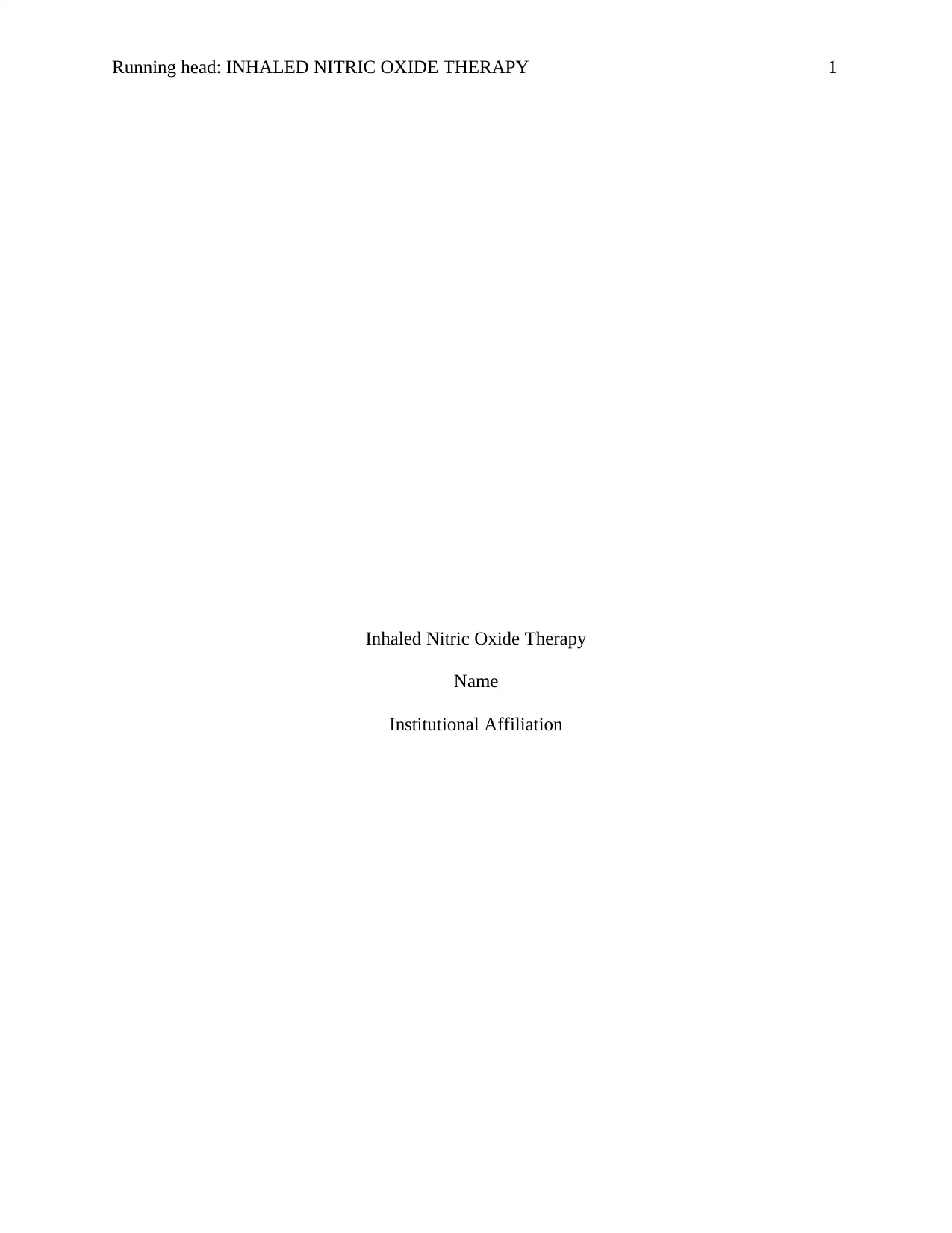
Running head: INHALED NITRIC OXIDE THERAPY 1
Inhaled Nitric Oxide Therapy
Name
Institutional Affiliation
Inhaled Nitric Oxide Therapy
Name
Institutional Affiliation
Paraphrase This Document
Need a fresh take? Get an instant paraphrase of this document with our AI Paraphraser
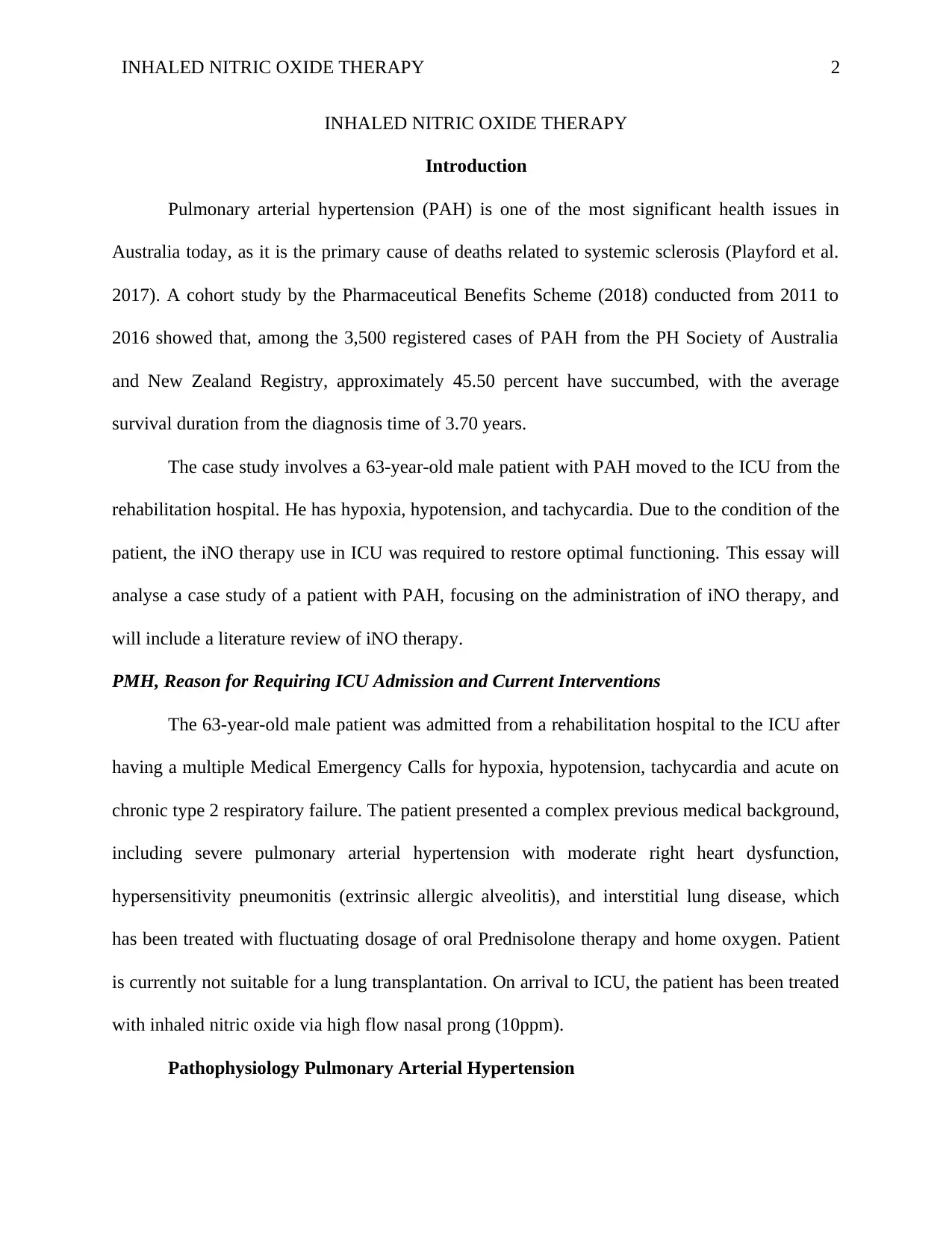
INHALED NITRIC OXIDE THERAPY 2
INHALED NITRIC OXIDE THERAPY
Introduction
Pulmonary arterial hypertension (PAH) is one of the most significant health issues in
Australia today, as it is the primary cause of deaths related to systemic sclerosis (Playford et al.
2017). A cohort study by the Pharmaceutical Benefits Scheme (2018) conducted from 2011 to
2016 showed that, among the 3,500 registered cases of PAH from the PH Society of Australia
and New Zealand Registry, approximately 45.50 percent have succumbed, with the average
survival duration from the diagnosis time of 3.70 years.
The case study involves a 63-year-old male patient with PAH moved to the ICU from the
rehabilitation hospital. He has hypoxia, hypotension, and tachycardia. Due to the condition of the
patient, the iNO therapy use in ICU was required to restore optimal functioning. This essay will
analyse a case study of a patient with PAH, focusing on the administration of iNO therapy, and
will include a literature review of iNO therapy.
PMH, Reason for Requiring ICU Admission and Current Interventions
The 63-year-old male patient was admitted from a rehabilitation hospital to the ICU after
having a multiple Medical Emergency Calls for hypoxia, hypotension, tachycardia and acute on
chronic type 2 respiratory failure. The patient presented a complex previous medical background,
including severe pulmonary arterial hypertension with moderate right heart dysfunction,
hypersensitivity pneumonitis (extrinsic allergic alveolitis), and interstitial lung disease, which
has been treated with fluctuating dosage of oral Prednisolone therapy and home oxygen. Patient
is currently not suitable for a lung transplantation. On arrival to ICU, the patient has been treated
with inhaled nitric oxide via high flow nasal prong (10ppm).
Pathophysiology Pulmonary Arterial Hypertension
INHALED NITRIC OXIDE THERAPY
Introduction
Pulmonary arterial hypertension (PAH) is one of the most significant health issues in
Australia today, as it is the primary cause of deaths related to systemic sclerosis (Playford et al.
2017). A cohort study by the Pharmaceutical Benefits Scheme (2018) conducted from 2011 to
2016 showed that, among the 3,500 registered cases of PAH from the PH Society of Australia
and New Zealand Registry, approximately 45.50 percent have succumbed, with the average
survival duration from the diagnosis time of 3.70 years.
The case study involves a 63-year-old male patient with PAH moved to the ICU from the
rehabilitation hospital. He has hypoxia, hypotension, and tachycardia. Due to the condition of the
patient, the iNO therapy use in ICU was required to restore optimal functioning. This essay will
analyse a case study of a patient with PAH, focusing on the administration of iNO therapy, and
will include a literature review of iNO therapy.
PMH, Reason for Requiring ICU Admission and Current Interventions
The 63-year-old male patient was admitted from a rehabilitation hospital to the ICU after
having a multiple Medical Emergency Calls for hypoxia, hypotension, tachycardia and acute on
chronic type 2 respiratory failure. The patient presented a complex previous medical background,
including severe pulmonary arterial hypertension with moderate right heart dysfunction,
hypersensitivity pneumonitis (extrinsic allergic alveolitis), and interstitial lung disease, which
has been treated with fluctuating dosage of oral Prednisolone therapy and home oxygen. Patient
is currently not suitable for a lung transplantation. On arrival to ICU, the patient has been treated
with inhaled nitric oxide via high flow nasal prong (10ppm).
Pathophysiology Pulmonary Arterial Hypertension
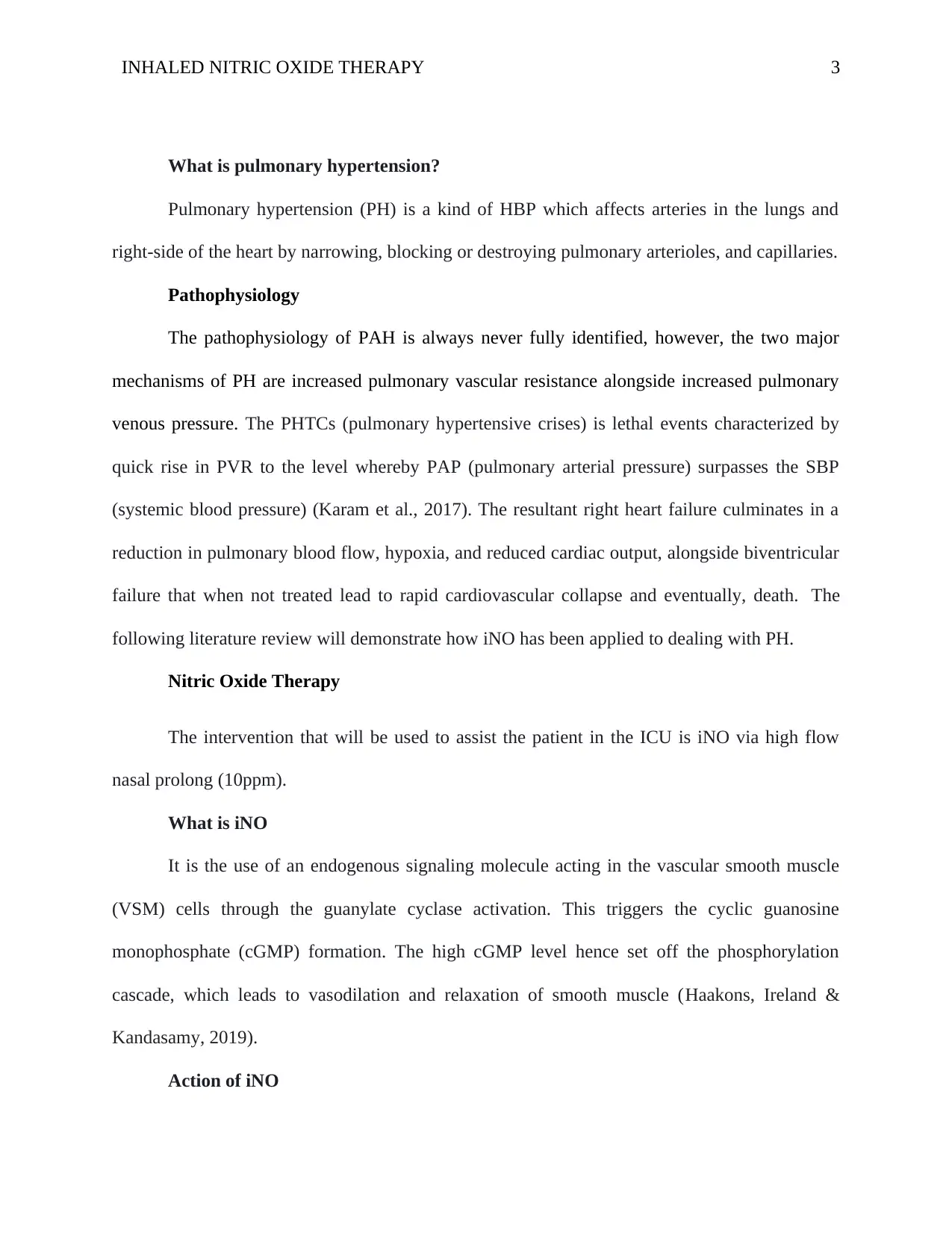
INHALED NITRIC OXIDE THERAPY 3
What is pulmonary hypertension?
Pulmonary hypertension (PH) is a kind of HBP which affects arteries in the lungs and
right-side of the heart by narrowing, blocking or destroying pulmonary arterioles, and capillaries.
Pathophysiology
The pathophysiology of PAH is always never fully identified, however, the two major
mechanisms of PH are increased pulmonary vascular resistance alongside increased pulmonary
venous pressure. The PHTCs (pulmonary hypertensive crises) is lethal events characterized by
quick rise in PVR to the level whereby PAP (pulmonary arterial pressure) surpasses the SBP
(systemic blood pressure) (Karam et al., 2017). The resultant right heart failure culminates in a
reduction in pulmonary blood flow, hypoxia, and reduced cardiac output, alongside biventricular
failure that when not treated lead to rapid cardiovascular collapse and eventually, death. The
following literature review will demonstrate how iNO has been applied to dealing with PH.
Nitric Oxide Therapy
The intervention that will be used to assist the patient in the ICU is iNO via high flow
nasal prolong (10ppm).
What is iNO
It is the use of an endogenous signaling molecule acting in the vascular smooth muscle
(VSM) cells through the guanylate cyclase activation. This triggers the cyclic guanosine
monophosphate (cGMP) formation. The high cGMP level hence set off the phosphorylation
cascade, which leads to vasodilation and relaxation of smooth muscle (Haakons, Ireland &
Kandasamy, 2019).
Action of iNO
What is pulmonary hypertension?
Pulmonary hypertension (PH) is a kind of HBP which affects arteries in the lungs and
right-side of the heart by narrowing, blocking or destroying pulmonary arterioles, and capillaries.
Pathophysiology
The pathophysiology of PAH is always never fully identified, however, the two major
mechanisms of PH are increased pulmonary vascular resistance alongside increased pulmonary
venous pressure. The PHTCs (pulmonary hypertensive crises) is lethal events characterized by
quick rise in PVR to the level whereby PAP (pulmonary arterial pressure) surpasses the SBP
(systemic blood pressure) (Karam et al., 2017). The resultant right heart failure culminates in a
reduction in pulmonary blood flow, hypoxia, and reduced cardiac output, alongside biventricular
failure that when not treated lead to rapid cardiovascular collapse and eventually, death. The
following literature review will demonstrate how iNO has been applied to dealing with PH.
Nitric Oxide Therapy
The intervention that will be used to assist the patient in the ICU is iNO via high flow
nasal prolong (10ppm).
What is iNO
It is the use of an endogenous signaling molecule acting in the vascular smooth muscle
(VSM) cells through the guanylate cyclase activation. This triggers the cyclic guanosine
monophosphate (cGMP) formation. The high cGMP level hence set off the phosphorylation
cascade, which leads to vasodilation and relaxation of smooth muscle (Haakons, Ireland &
Kandasamy, 2019).
Action of iNO
⊘ This is a preview!⊘
Do you want full access?
Subscribe today to unlock all pages.

Trusted by 1+ million students worldwide
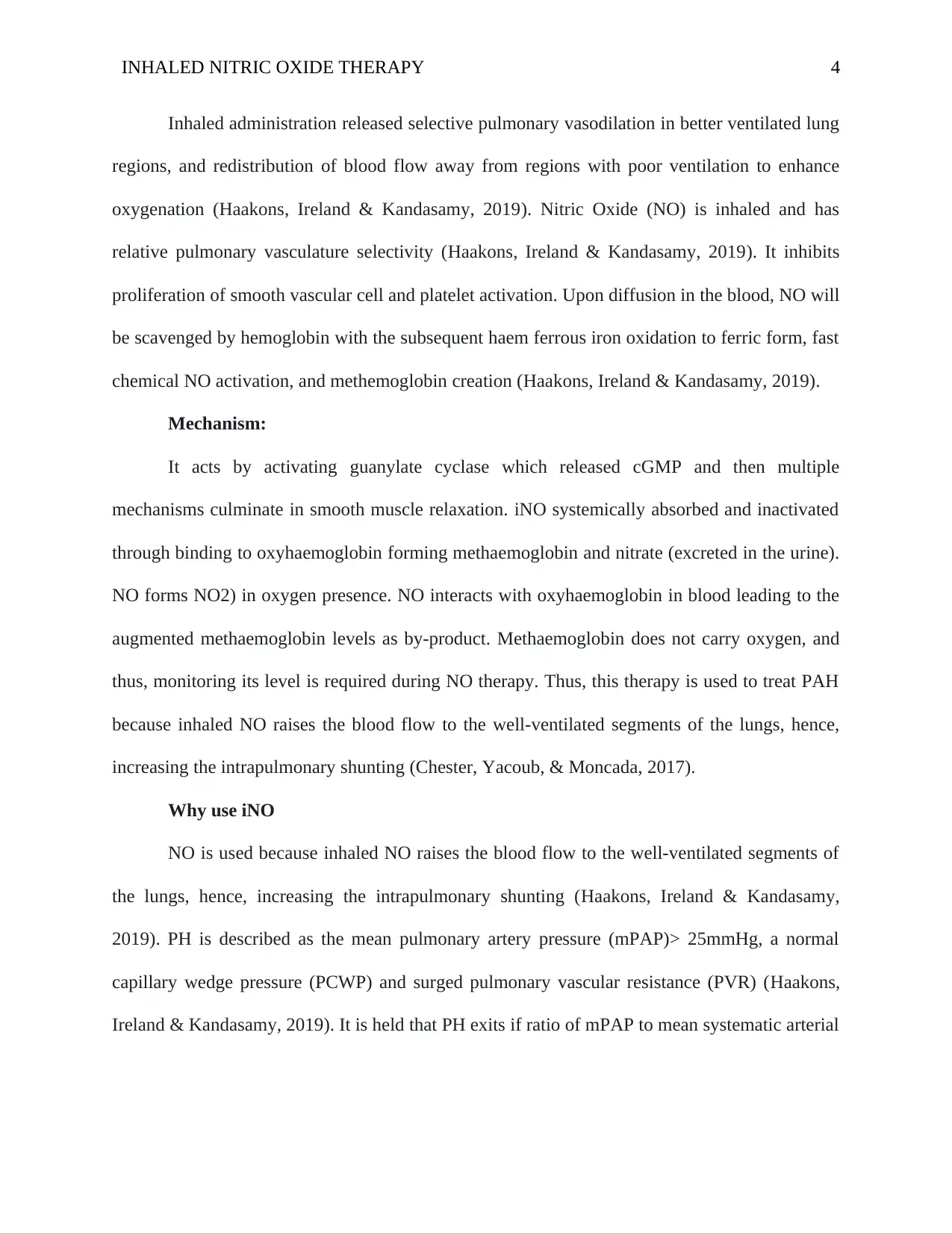
INHALED NITRIC OXIDE THERAPY 4
Inhaled administration released selective pulmonary vasodilation in better ventilated lung
regions, and redistribution of blood flow away from regions with poor ventilation to enhance
oxygenation (Haakons, Ireland & Kandasamy, 2019). Nitric Oxide (NO) is inhaled and has
relative pulmonary vasculature selectivity (Haakons, Ireland & Kandasamy, 2019). It inhibits
proliferation of smooth vascular cell and platelet activation. Upon diffusion in the blood, NO will
be scavenged by hemoglobin with the subsequent haem ferrous iron oxidation to ferric form, fast
chemical NO activation, and methemoglobin creation (Haakons, Ireland & Kandasamy, 2019).
Mechanism:
It acts by activating guanylate cyclase which released cGMP and then multiple
mechanisms culminate in smooth muscle relaxation. iNO systemically absorbed and inactivated
through binding to oxyhaemoglobin forming methaemoglobin and nitrate (excreted in the urine).
NO forms NO2) in oxygen presence. NO interacts with oxyhaemoglobin in blood leading to the
augmented methaemoglobin levels as by-product. Methaemoglobin does not carry oxygen, and
thus, monitoring its level is required during NO therapy. Thus, this therapy is used to treat PAH
because inhaled NO raises the blood flow to the well-ventilated segments of the lungs, hence,
increasing the intrapulmonary shunting (Chester, Yacoub, & Moncada, 2017).
Why use iNO
NO is used because inhaled NO raises the blood flow to the well-ventilated segments of
the lungs, hence, increasing the intrapulmonary shunting (Haakons, Ireland & Kandasamy,
2019). PH is described as the mean pulmonary artery pressure (mPAP)> 25mmHg, a normal
capillary wedge pressure (PCWP) and surged pulmonary vascular resistance (PVR) (Haakons,
Ireland & Kandasamy, 2019). It is held that PH exits if ratio of mPAP to mean systematic arterial
Inhaled administration released selective pulmonary vasodilation in better ventilated lung
regions, and redistribution of blood flow away from regions with poor ventilation to enhance
oxygenation (Haakons, Ireland & Kandasamy, 2019). Nitric Oxide (NO) is inhaled and has
relative pulmonary vasculature selectivity (Haakons, Ireland & Kandasamy, 2019). It inhibits
proliferation of smooth vascular cell and platelet activation. Upon diffusion in the blood, NO will
be scavenged by hemoglobin with the subsequent haem ferrous iron oxidation to ferric form, fast
chemical NO activation, and methemoglobin creation (Haakons, Ireland & Kandasamy, 2019).
Mechanism:
It acts by activating guanylate cyclase which released cGMP and then multiple
mechanisms culminate in smooth muscle relaxation. iNO systemically absorbed and inactivated
through binding to oxyhaemoglobin forming methaemoglobin and nitrate (excreted in the urine).
NO forms NO2) in oxygen presence. NO interacts with oxyhaemoglobin in blood leading to the
augmented methaemoglobin levels as by-product. Methaemoglobin does not carry oxygen, and
thus, monitoring its level is required during NO therapy. Thus, this therapy is used to treat PAH
because inhaled NO raises the blood flow to the well-ventilated segments of the lungs, hence,
increasing the intrapulmonary shunting (Chester, Yacoub, & Moncada, 2017).
Why use iNO
NO is used because inhaled NO raises the blood flow to the well-ventilated segments of
the lungs, hence, increasing the intrapulmonary shunting (Haakons, Ireland & Kandasamy,
2019). PH is described as the mean pulmonary artery pressure (mPAP)> 25mmHg, a normal
capillary wedge pressure (PCWP) and surged pulmonary vascular resistance (PVR) (Haakons,
Ireland & Kandasamy, 2019). It is held that PH exits if ratio of mPAP to mean systematic arterial
Paraphrase This Document
Need a fresh take? Get an instant paraphrase of this document with our AI Paraphraser
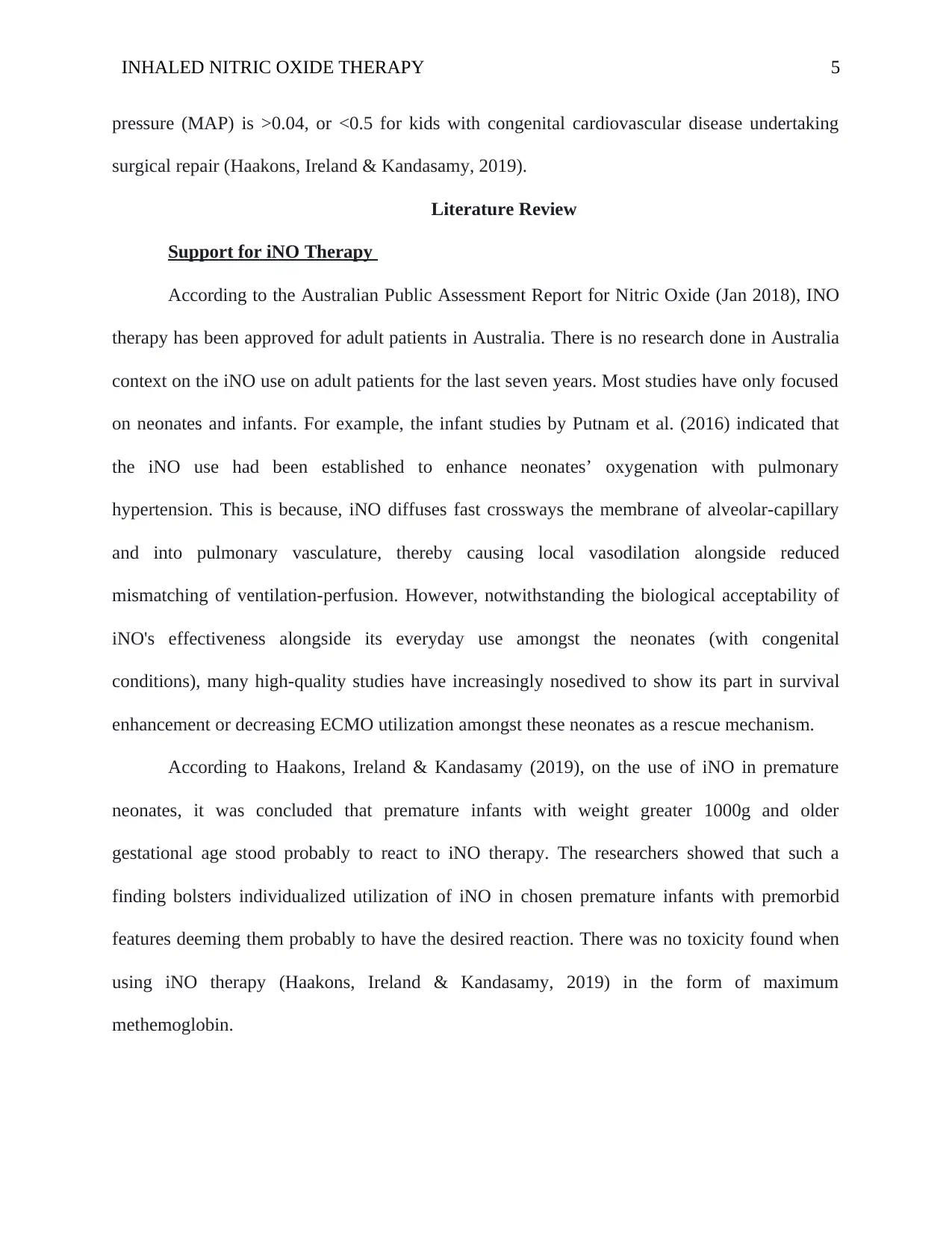
INHALED NITRIC OXIDE THERAPY 5
pressure (MAP) is >0.04, or <0.5 for kids with congenital cardiovascular disease undertaking
surgical repair (Haakons, Ireland & Kandasamy, 2019).
Literature Review
Support for iNO Therapy
According to the Australian Public Assessment Report for Nitric Oxide (Jan 2018), INO
therapy has been approved for adult patients in Australia. There is no research done in Australia
context on the iNO use on adult patients for the last seven years. Most studies have only focused
on neonates and infants. For example, the infant studies by Putnam et al. (2016) indicated that
the iNO use had been established to enhance neonates’ oxygenation with pulmonary
hypertension. This is because, iNO diffuses fast crossways the membrane of alveolar-capillary
and into pulmonary vasculature, thereby causing local vasodilation alongside reduced
mismatching of ventilation-perfusion. However, notwithstanding the biological acceptability of
iNO's effectiveness alongside its everyday use amongst the neonates (with congenital
conditions), many high-quality studies have increasingly nosedived to show its part in survival
enhancement or decreasing ECMO utilization amongst these neonates as a rescue mechanism.
According to Haakons, Ireland & Kandasamy (2019), on the use of iNO in premature
neonates, it was concluded that premature infants with weight greater 1000g and older
gestational age stood probably to react to iNO therapy. The researchers showed that such a
finding bolsters individualized utilization of iNO in chosen premature infants with premorbid
features deeming them probably to have the desired reaction. There was no toxicity found when
using iNO therapy (Haakons, Ireland & Kandasamy, 2019) in the form of maximum
methemoglobin.
pressure (MAP) is >0.04, or <0.5 for kids with congenital cardiovascular disease undertaking
surgical repair (Haakons, Ireland & Kandasamy, 2019).
Literature Review
Support for iNO Therapy
According to the Australian Public Assessment Report for Nitric Oxide (Jan 2018), INO
therapy has been approved for adult patients in Australia. There is no research done in Australia
context on the iNO use on adult patients for the last seven years. Most studies have only focused
on neonates and infants. For example, the infant studies by Putnam et al. (2016) indicated that
the iNO use had been established to enhance neonates’ oxygenation with pulmonary
hypertension. This is because, iNO diffuses fast crossways the membrane of alveolar-capillary
and into pulmonary vasculature, thereby causing local vasodilation alongside reduced
mismatching of ventilation-perfusion. However, notwithstanding the biological acceptability of
iNO's effectiveness alongside its everyday use amongst the neonates (with congenital
conditions), many high-quality studies have increasingly nosedived to show its part in survival
enhancement or decreasing ECMO utilization amongst these neonates as a rescue mechanism.
According to Haakons, Ireland & Kandasamy (2019), on the use of iNO in premature
neonates, it was concluded that premature infants with weight greater 1000g and older
gestational age stood probably to react to iNO therapy. The researchers showed that such a
finding bolsters individualized utilization of iNO in chosen premature infants with premorbid
features deeming them probably to have the desired reaction. There was no toxicity found when
using iNO therapy (Haakons, Ireland & Kandasamy, 2019) in the form of maximum
methemoglobin.
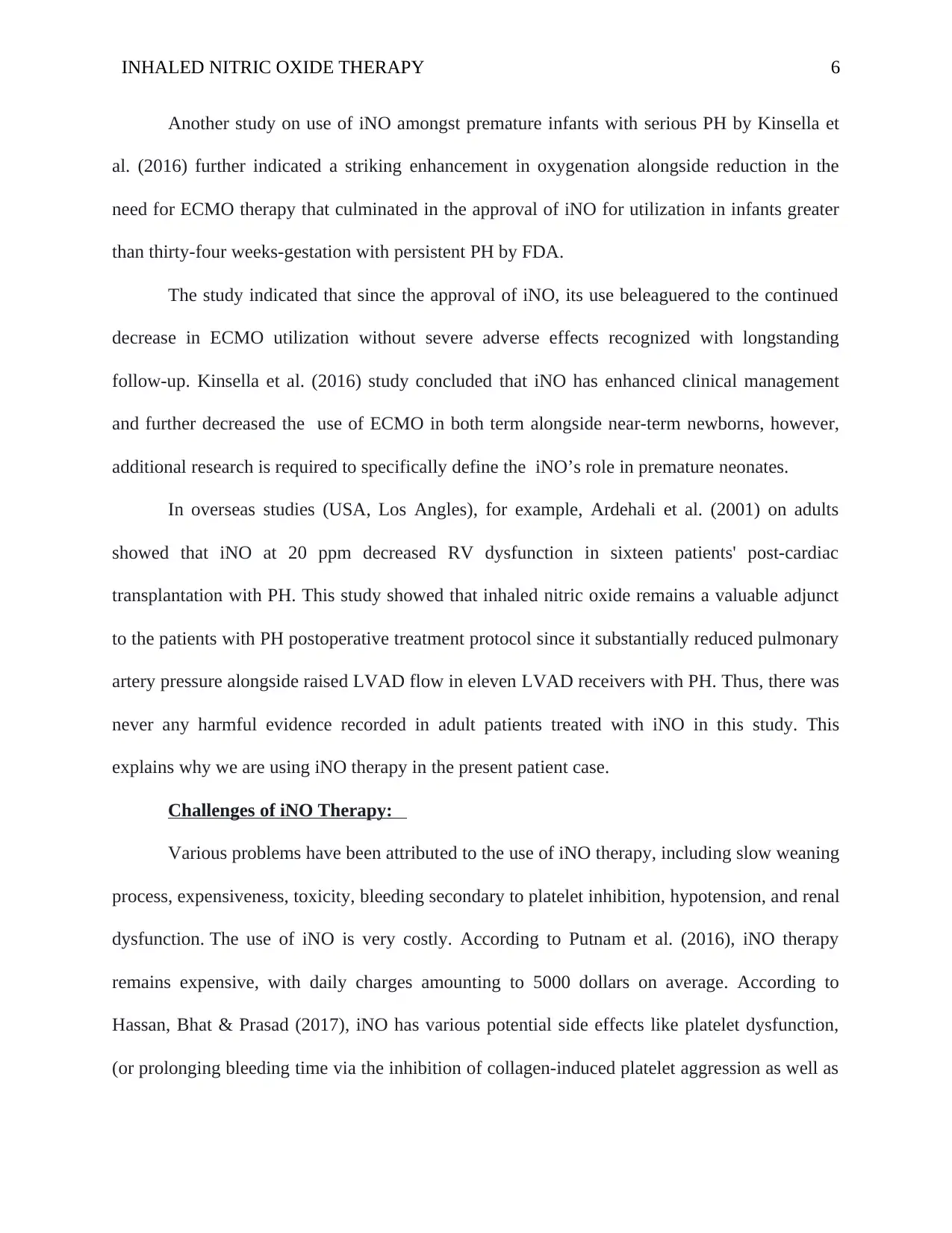
INHALED NITRIC OXIDE THERAPY 6
Another study on use of iNO amongst premature infants with serious PH by Kinsella et
al. (2016) further indicated a striking enhancement in oxygenation alongside reduction in the
need for ECMO therapy that culminated in the approval of iNO for utilization in infants greater
than thirty-four weeks-gestation with persistent PH by FDA.
The study indicated that since the approval of iNO, its use beleaguered to the continued
decrease in ECMO utilization without severe adverse effects recognized with longstanding
follow-up. Kinsella et al. (2016) study concluded that iNO has enhanced clinical management
and further decreased the use of ECMO in both term alongside near-term newborns, however,
additional research is required to specifically define the iNO’s role in premature neonates.
In overseas studies (USA, Los Angles), for example, Ardehali et al. (2001) on adults
showed that iNO at 20 ppm decreased RV dysfunction in sixteen patients' post-cardiac
transplantation with PH. This study showed that inhaled nitric oxide remains a valuable adjunct
to the patients with PH postoperative treatment protocol since it substantially reduced pulmonary
artery pressure alongside raised LVAD flow in eleven LVAD receivers with PH. Thus, there was
never any harmful evidence recorded in adult patients treated with iNO in this study. This
explains why we are using iNO therapy in the present patient case.
Challenges of iNO Therapy:
Various problems have been attributed to the use of iNO therapy, including slow weaning
process, expensiveness, toxicity, bleeding secondary to platelet inhibition, hypotension, and renal
dysfunction. The use of iNO is very costly. According to Putnam et al. (2016), iNO therapy
remains expensive, with daily charges amounting to 5000 dollars on average. According to
Hassan, Bhat & Prasad (2017), iNO has various potential side effects like platelet dysfunction,
(or prolonging bleeding time via the inhibition of collagen-induced platelet aggression as well as
Another study on use of iNO amongst premature infants with serious PH by Kinsella et
al. (2016) further indicated a striking enhancement in oxygenation alongside reduction in the
need for ECMO therapy that culminated in the approval of iNO for utilization in infants greater
than thirty-four weeks-gestation with persistent PH by FDA.
The study indicated that since the approval of iNO, its use beleaguered to the continued
decrease in ECMO utilization without severe adverse effects recognized with longstanding
follow-up. Kinsella et al. (2016) study concluded that iNO has enhanced clinical management
and further decreased the use of ECMO in both term alongside near-term newborns, however,
additional research is required to specifically define the iNO’s role in premature neonates.
In overseas studies (USA, Los Angles), for example, Ardehali et al. (2001) on adults
showed that iNO at 20 ppm decreased RV dysfunction in sixteen patients' post-cardiac
transplantation with PH. This study showed that inhaled nitric oxide remains a valuable adjunct
to the patients with PH postoperative treatment protocol since it substantially reduced pulmonary
artery pressure alongside raised LVAD flow in eleven LVAD receivers with PH. Thus, there was
never any harmful evidence recorded in adult patients treated with iNO in this study. This
explains why we are using iNO therapy in the present patient case.
Challenges of iNO Therapy:
Various problems have been attributed to the use of iNO therapy, including slow weaning
process, expensiveness, toxicity, bleeding secondary to platelet inhibition, hypotension, and renal
dysfunction. The use of iNO is very costly. According to Putnam et al. (2016), iNO therapy
remains expensive, with daily charges amounting to 5000 dollars on average. According to
Hassan, Bhat & Prasad (2017), iNO has various potential side effects like platelet dysfunction,
(or prolonging bleeding time via the inhibition of collagen-induced platelet aggression as well as
⊘ This is a preview!⊘
Do you want full access?
Subscribe today to unlock all pages.

Trusted by 1+ million students worldwide
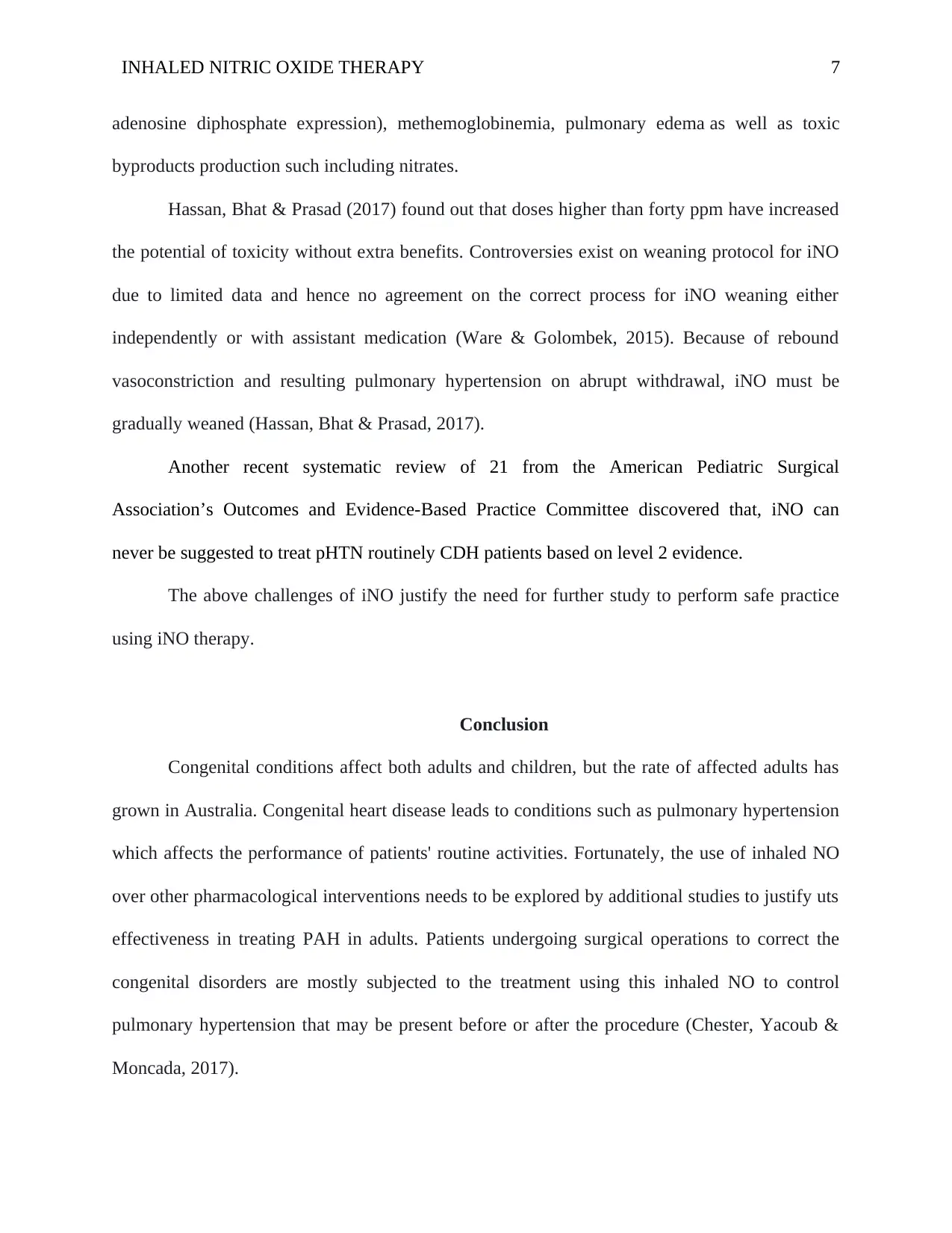
INHALED NITRIC OXIDE THERAPY 7
adenosine diphosphate expression), methemoglobinemia, pulmonary edema as well as toxic
byproducts production such including nitrates.
Hassan, Bhat & Prasad (2017) found out that doses higher than forty ppm have increased
the potential of toxicity without extra benefits. Controversies exist on weaning protocol for iNO
due to limited data and hence no agreement on the correct process for iNO weaning either
independently or with assistant medication (Ware & Golombek, 2015). Because of rebound
vasoconstriction and resulting pulmonary hypertension on abrupt withdrawal, iNO must be
gradually weaned (Hassan, Bhat & Prasad, 2017).
Another recent systematic review of 21 from the American Pediatric Surgical
Association’s Outcomes and Evidence-Based Practice Committee discovered that, iNO can
never be suggested to treat pHTN routinely CDH patients based on level 2 evidence.
The above challenges of iNO justify the need for further study to perform safe practice
using iNO therapy.
Conclusion
Congenital conditions affect both adults and children, but the rate of affected adults has
grown in Australia. Congenital heart disease leads to conditions such as pulmonary hypertension
which affects the performance of patients' routine activities. Fortunately, the use of inhaled NO
over other pharmacological interventions needs to be explored by additional studies to justify uts
effectiveness in treating PAH in adults. Patients undergoing surgical operations to correct the
congenital disorders are mostly subjected to the treatment using this inhaled NO to control
pulmonary hypertension that may be present before or after the procedure (Chester, Yacoub &
Moncada, 2017).
adenosine diphosphate expression), methemoglobinemia, pulmonary edema as well as toxic
byproducts production such including nitrates.
Hassan, Bhat & Prasad (2017) found out that doses higher than forty ppm have increased
the potential of toxicity without extra benefits. Controversies exist on weaning protocol for iNO
due to limited data and hence no agreement on the correct process for iNO weaning either
independently or with assistant medication (Ware & Golombek, 2015). Because of rebound
vasoconstriction and resulting pulmonary hypertension on abrupt withdrawal, iNO must be
gradually weaned (Hassan, Bhat & Prasad, 2017).
Another recent systematic review of 21 from the American Pediatric Surgical
Association’s Outcomes and Evidence-Based Practice Committee discovered that, iNO can
never be suggested to treat pHTN routinely CDH patients based on level 2 evidence.
The above challenges of iNO justify the need for further study to perform safe practice
using iNO therapy.
Conclusion
Congenital conditions affect both adults and children, but the rate of affected adults has
grown in Australia. Congenital heart disease leads to conditions such as pulmonary hypertension
which affects the performance of patients' routine activities. Fortunately, the use of inhaled NO
over other pharmacological interventions needs to be explored by additional studies to justify uts
effectiveness in treating PAH in adults. Patients undergoing surgical operations to correct the
congenital disorders are mostly subjected to the treatment using this inhaled NO to control
pulmonary hypertension that may be present before or after the procedure (Chester, Yacoub &
Moncada, 2017).
Paraphrase This Document
Need a fresh take? Get an instant paraphrase of this document with our AI Paraphraser
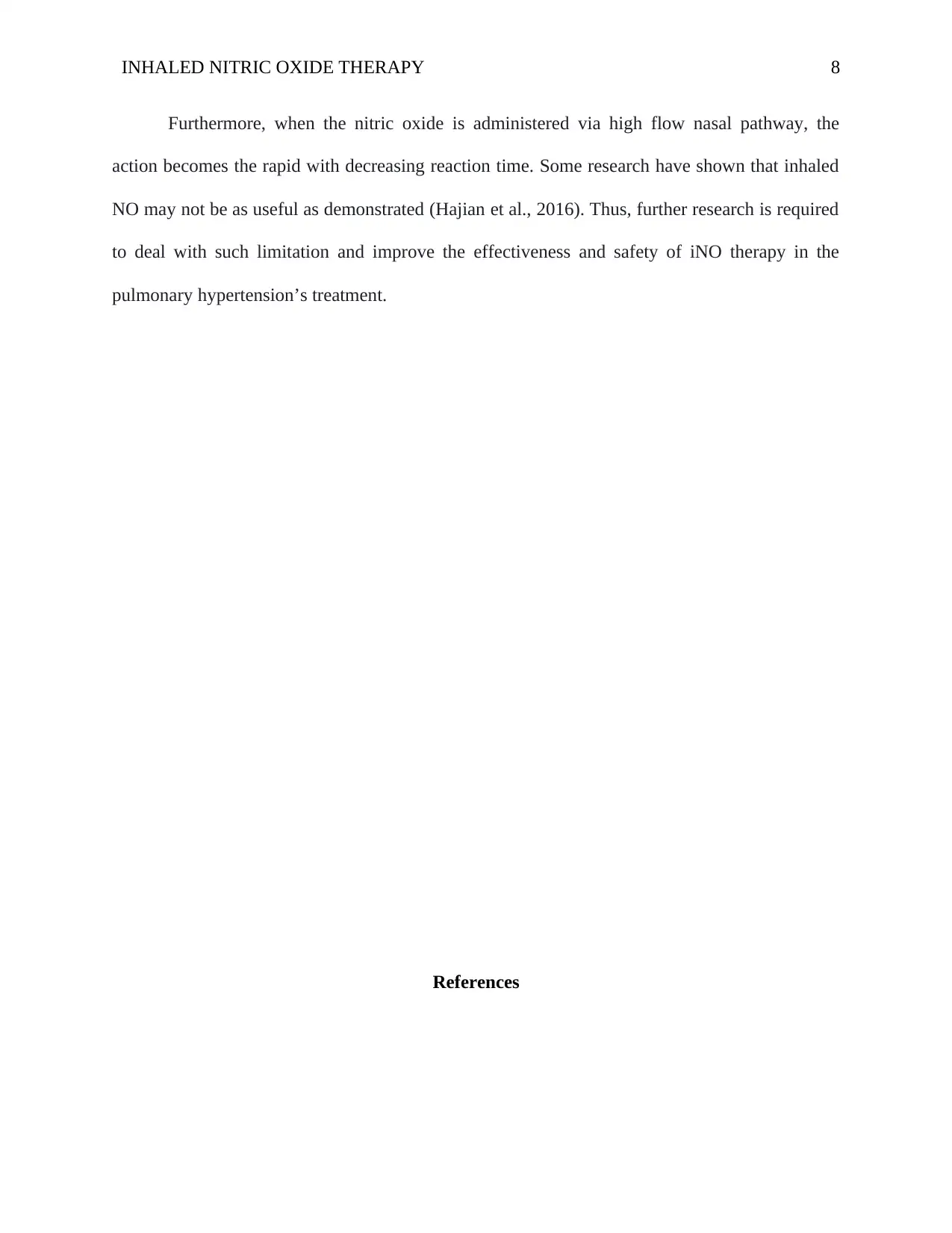
INHALED NITRIC OXIDE THERAPY 8
Furthermore, when the nitric oxide is administered via high flow nasal pathway, the
action becomes the rapid with decreasing reaction time. Some research have shown that inhaled
NO may not be as useful as demonstrated (Hajian et al., 2016). Thus, further research is required
to deal with such limitation and improve the effectiveness and safety of iNO therapy in the
pulmonary hypertension’s treatment.
References
Furthermore, when the nitric oxide is administered via high flow nasal pathway, the
action becomes the rapid with decreasing reaction time. Some research have shown that inhaled
NO may not be as useful as demonstrated (Hajian et al., 2016). Thus, further research is required
to deal with such limitation and improve the effectiveness and safety of iNO therapy in the
pulmonary hypertension’s treatment.
References
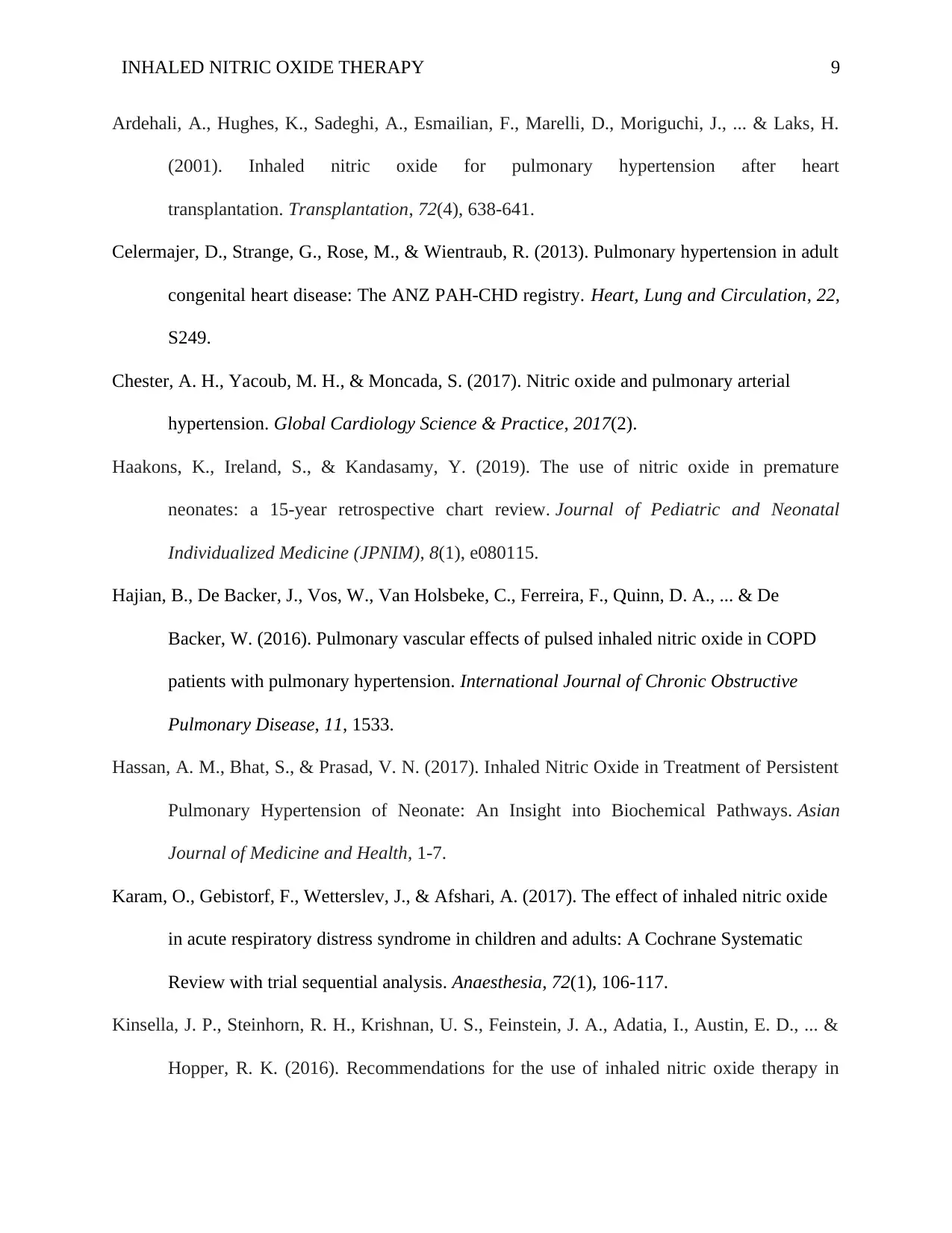
INHALED NITRIC OXIDE THERAPY 9
Ardehali, A., Hughes, K., Sadeghi, A., Esmailian, F., Marelli, D., Moriguchi, J., ... & Laks, H.
(2001). Inhaled nitric oxide for pulmonary hypertension after heart
transplantation. Transplantation, 72(4), 638-641.
Celermajer, D., Strange, G., Rose, M., & Wientraub, R. (2013). Pulmonary hypertension in adult
congenital heart disease: The ANZ PAH-CHD registry. Heart, Lung and Circulation, 22,
S249.
Chester, A. H., Yacoub, M. H., & Moncada, S. (2017). Nitric oxide and pulmonary arterial
hypertension. Global Cardiology Science & Practice, 2017(2).
Haakons, K., Ireland, S., & Kandasamy, Y. (2019). The use of nitric oxide in premature
neonates: a 15-year retrospective chart review. Journal of Pediatric and Neonatal
Individualized Medicine (JPNIM), 8(1), e080115.
Hajian, B., De Backer, J., Vos, W., Van Holsbeke, C., Ferreira, F., Quinn, D. A., ... & De
Backer, W. (2016). Pulmonary vascular effects of pulsed inhaled nitric oxide in COPD
patients with pulmonary hypertension. International Journal of Chronic Obstructive
Pulmonary Disease, 11, 1533.
Hassan, A. M., Bhat, S., & Prasad, V. N. (2017). Inhaled Nitric Oxide in Treatment of Persistent
Pulmonary Hypertension of Neonate: An Insight into Biochemical Pathways. Asian
Journal of Medicine and Health, 1-7.
Karam, O., Gebistorf, F., Wetterslev, J., & Afshari, A. (2017). The effect of inhaled nitric oxide
in acute respiratory distress syndrome in children and adults: A Cochrane Systematic
Review with trial sequential analysis. Anaesthesia, 72(1), 106-117.
Kinsella, J. P., Steinhorn, R. H., Krishnan, U. S., Feinstein, J. A., Adatia, I., Austin, E. D., ... &
Hopper, R. K. (2016). Recommendations for the use of inhaled nitric oxide therapy in
Ardehali, A., Hughes, K., Sadeghi, A., Esmailian, F., Marelli, D., Moriguchi, J., ... & Laks, H.
(2001). Inhaled nitric oxide for pulmonary hypertension after heart
transplantation. Transplantation, 72(4), 638-641.
Celermajer, D., Strange, G., Rose, M., & Wientraub, R. (2013). Pulmonary hypertension in adult
congenital heart disease: The ANZ PAH-CHD registry. Heart, Lung and Circulation, 22,
S249.
Chester, A. H., Yacoub, M. H., & Moncada, S. (2017). Nitric oxide and pulmonary arterial
hypertension. Global Cardiology Science & Practice, 2017(2).
Haakons, K., Ireland, S., & Kandasamy, Y. (2019). The use of nitric oxide in premature
neonates: a 15-year retrospective chart review. Journal of Pediatric and Neonatal
Individualized Medicine (JPNIM), 8(1), e080115.
Hajian, B., De Backer, J., Vos, W., Van Holsbeke, C., Ferreira, F., Quinn, D. A., ... & De
Backer, W. (2016). Pulmonary vascular effects of pulsed inhaled nitric oxide in COPD
patients with pulmonary hypertension. International Journal of Chronic Obstructive
Pulmonary Disease, 11, 1533.
Hassan, A. M., Bhat, S., & Prasad, V. N. (2017). Inhaled Nitric Oxide in Treatment of Persistent
Pulmonary Hypertension of Neonate: An Insight into Biochemical Pathways. Asian
Journal of Medicine and Health, 1-7.
Karam, O., Gebistorf, F., Wetterslev, J., & Afshari, A. (2017). The effect of inhaled nitric oxide
in acute respiratory distress syndrome in children and adults: A Cochrane Systematic
Review with trial sequential analysis. Anaesthesia, 72(1), 106-117.
Kinsella, J. P., Steinhorn, R. H., Krishnan, U. S., Feinstein, J. A., Adatia, I., Austin, E. D., ... &
Hopper, R. K. (2016). Recommendations for the use of inhaled nitric oxide therapy in
⊘ This is a preview!⊘
Do you want full access?
Subscribe today to unlock all pages.

Trusted by 1+ million students worldwide
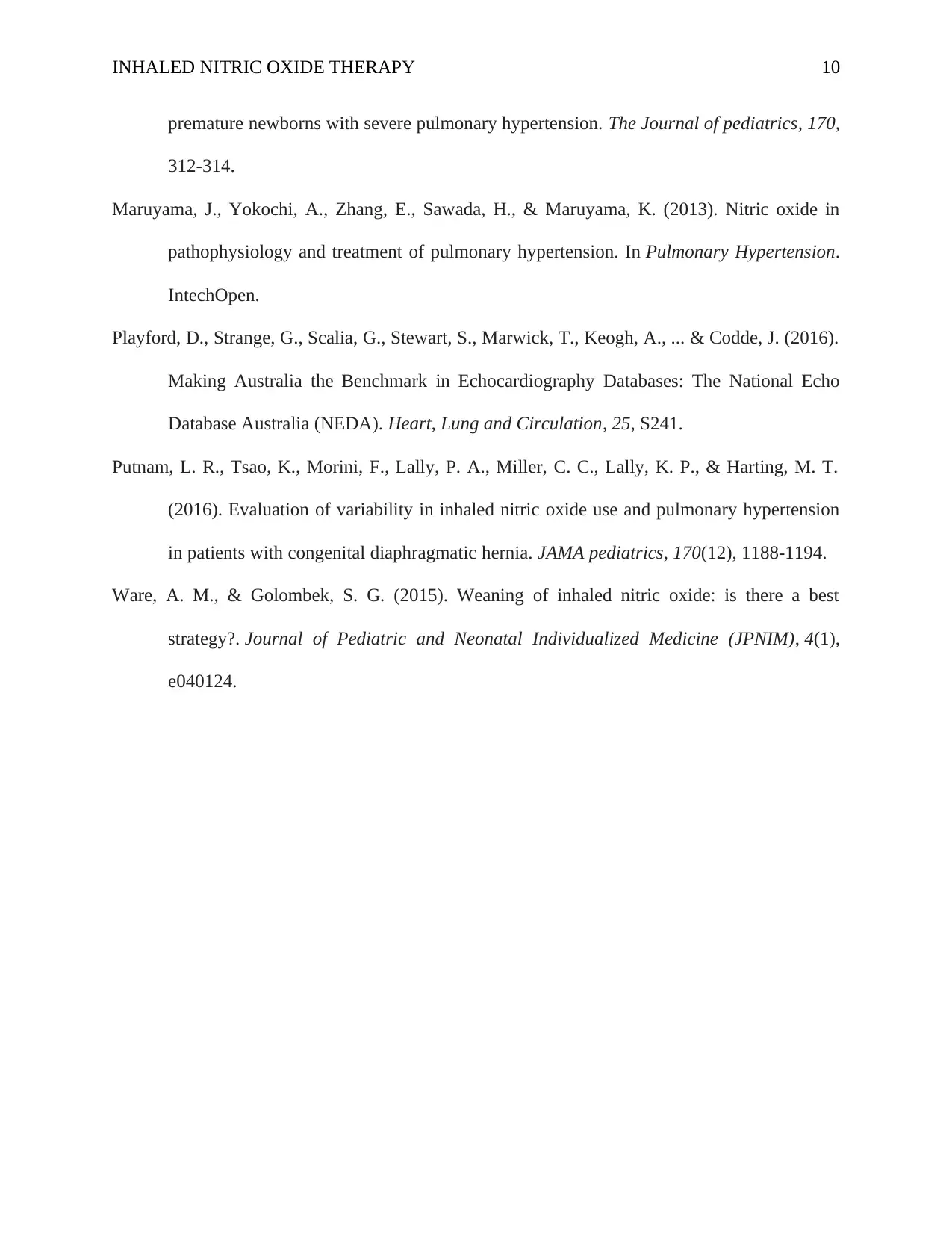
INHALED NITRIC OXIDE THERAPY 10
premature newborns with severe pulmonary hypertension. The Journal of pediatrics, 170,
312-314.
Maruyama, J., Yokochi, A., Zhang, E., Sawada, H., & Maruyama, K. (2013). Nitric oxide in
pathophysiology and treatment of pulmonary hypertension. In Pulmonary Hypertension.
IntechOpen.
Playford, D., Strange, G., Scalia, G., Stewart, S., Marwick, T., Keogh, A., ... & Codde, J. (2016).
Making Australia the Benchmark in Echocardiography Databases: The National Echo
Database Australia (NEDA). Heart, Lung and Circulation, 25, S241.
Putnam, L. R., Tsao, K., Morini, F., Lally, P. A., Miller, C. C., Lally, K. P., & Harting, M. T.
(2016). Evaluation of variability in inhaled nitric oxide use and pulmonary hypertension
in patients with congenital diaphragmatic hernia. JAMA pediatrics, 170(12), 1188-1194.
Ware, A. M., & Golombek, S. G. (2015). Weaning of inhaled nitric oxide: is there a best
strategy?. Journal of Pediatric and Neonatal Individualized Medicine (JPNIM), 4(1),
e040124.
premature newborns with severe pulmonary hypertension. The Journal of pediatrics, 170,
312-314.
Maruyama, J., Yokochi, A., Zhang, E., Sawada, H., & Maruyama, K. (2013). Nitric oxide in
pathophysiology and treatment of pulmonary hypertension. In Pulmonary Hypertension.
IntechOpen.
Playford, D., Strange, G., Scalia, G., Stewart, S., Marwick, T., Keogh, A., ... & Codde, J. (2016).
Making Australia the Benchmark in Echocardiography Databases: The National Echo
Database Australia (NEDA). Heart, Lung and Circulation, 25, S241.
Putnam, L. R., Tsao, K., Morini, F., Lally, P. A., Miller, C. C., Lally, K. P., & Harting, M. T.
(2016). Evaluation of variability in inhaled nitric oxide use and pulmonary hypertension
in patients with congenital diaphragmatic hernia. JAMA pediatrics, 170(12), 1188-1194.
Ware, A. M., & Golombek, S. G. (2015). Weaning of inhaled nitric oxide: is there a best
strategy?. Journal of Pediatric and Neonatal Individualized Medicine (JPNIM), 4(1),
e040124.
1 out of 10
Your All-in-One AI-Powered Toolkit for Academic Success.
+13062052269
info@desklib.com
Available 24*7 on WhatsApp / Email
![[object Object]](/_next/static/media/star-bottom.7253800d.svg)
Unlock your academic potential
Copyright © 2020–2025 A2Z Services. All Rights Reserved. Developed and managed by ZUCOL.